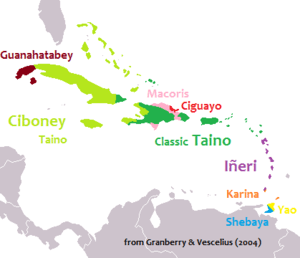Guanahatabey language
| Guanahatabey | |
|---|---|
| Native to | Cuba |
| Region | Pinar del Río Province and Isla de la Juventud |
| Ethnicity | Guanahatabey |
| Extinct | 16th century |
|
unclassified (one of the pre-Arawakan languages of the Greater Antilles) | |
| Language codes | |
| ISO 639-3 |
None (mis) |
| Glottolog | None |
|
Precolombian languages of the Antilles.
Guanahatabey
Ciboney Taíno, Classic Taíno, and Iñeri were Arawakan, Karina and Yao were Cariban. Macorix, Ciguayo and Guanahatabey are unclassified. | |
Guanahatabey (Guanajatabey) was the language of the Guanahatabey people, an archaic hunter-gatherer society living in western Cuba until the 16th century. Very little is known of it, as the Guanahatabey died off early in the period of Spanish colonization before substantial information about them was recorded. Evidence suggests it was distinct from the Taíno language spoken in the rest of the island.[1][2]
Description
The Guanahatabey were archaic hunter-gathers and appear to have predated the agricultural Ciboney, a Taíno group who inhabited most of Cuba. By the contact period, they lived primarily in far western Pinar del Río Province, which was never settled by the Ciboney or Classic Taíno of the eastern island, and was colonized by the Spanish relatively late. Spanish accounts indicate that Guanahatabey was distinct from and mutually unintelligible with the Taíno language spoken in the rest of Cuba and throughout the Caribbean.[1][3] Not a single word of the Guanahatabey language survives. However, Julian Granberry and Gary Vescelius have identified five placenames that they consider non-Taíno, and which may thus derive from Guanahatabey. Granberry and Vescelius argue that the names have parallels in the Warao language, and further suggest a possible connection with the Macoris language of Hispaniola.[4]
| Name | Warao parallel | Warao meaning |
|---|---|---|
| Camujiro | ka-muhi-ru | 'palm-tree trunks' |
| Guara | wara | 'white heron' |
| Guaniguaníco (Mountain range in western Cuba) | wani-wani-ku | 'hidden moon, moon-set' |
| Hanábona (a savannah) | hana-bana | 'sugarcane plumes' |
| Júcaro (three locations) | hu-karo | 'double pointed, tree crotch' |
See also
Notes
References
- Granberry, Julian; Vescelius, Gary (1992). Languages of the Pre-Columbian Antilles. University of Alabama Press. ISBN 081735123X.
- Rouse, Irving (1992). The Tainos. Yale University Press. ISBN 0300051816.
